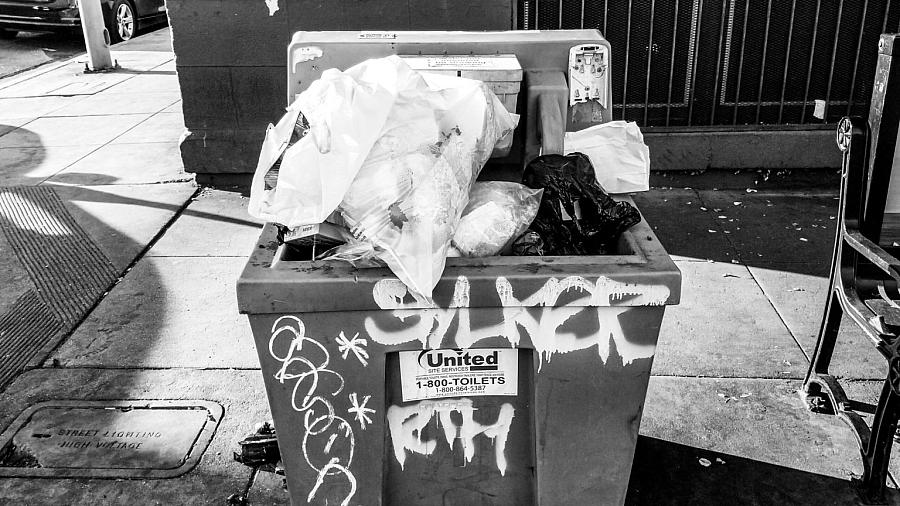Three journalists share key takeaways on using data to power big projects

An unmaintained handwashing station in Los Angeles.
(Photo by Lexis Olivier-Ray)
Often when reporters first think of data journalism, they envision a crisp, linear process: Track down the right dataset, and then sort and analyze it until the spreadsheet surrenders a few stark numbers that crystallize the crisis. At that point, it’s just a matter of finding the right human stories to exemplify the trend.
Rarely does data reporting follow such a pat course, however, as three previous Data Fellows explained to fellow reporters just embarking on their own data journeys at the 2021 Data Fellowship, held via Zoom this week.
For Lexis-Olivier Ray, a former freelancer who is now a staff reporter at L.A. Taco, it was shoe-leather reporting in the form of long walks through central L.A. neighborhoods that turned him onto the problem: Handwashing stations around homeless camps were not being maintained in the midst of a deadly pandemic.
Ray initially found the data he needed by collecting it himself, visiting every hygiene station in a chosen neighborhood and logging what he found. He later bolstered that data with extensive public records from the city. “Meanwhile, vendors were being paid millions of dollars, essentially for work they were not completing,” he said.
Rebecca Lindstrom, an investigative reporter for 11Alive, started by submitting a series of public records requests to Georgia’s child welfare agencies to help answer the question of which children were being abandoned the most in the state. That early records and data work helped her narrow her focus to teenagers, and then the project became about finding the right families to feature.
“Once I identified this group that seemed the most impacted by this, I got on the phone and started talking to people,” she said. “If we can’t find those stories to wrap around the data, people will just gloss over it.”
For reporter Ginny Monk of the Arkansas Democrat-Gazette, whose 2019 Data Fellowship project focused on child deaths in Arkansas, creating her own database proved to be a herculean challenge. The painstaking effort ultimately spanned three years and involved detailed FOIA requests sent to every prosecutor and county coroner in the state, which she combined with policy reports and records from the Arkansas Department of Human Services. Over time Monk was able to build a database on the deaths of 1,500 minors dating back to 2012.
Once that massive records and data reporting effort started to coalesce, Monk began identifying patterns in how children were dying from preventable and unnatural deaths in the state. Her harrowing three-part series, “Children in Peril,” focused on child deaths by gun violence, suicide and abuse.
When asked for their central takeaway from their reporting projects, the trio offered very different answers.
For Ray, one of his biggest lessons was to reach out to the subject of an investigation early on in the reporting. As a former freelancer used to working with little support, that idea felt counterintuitive and made him feel a little fearful at first. Wouldn’t it be better to present them with fully buttressed findings at the end and await comment? But he actually found that City Hall became increasingly responsive and helpful, and his reporting evolved — he was eventually able to obtain purchase orders and contracts in a few days from city officials, rather than file lengthy records requests and wait. City officials later thanked him for his reporting, he said.
“Even if they’re not that helpful, I think it’s just good to reach out, because when you present them with your findings, you might be able to make a more interesting story out of their responses,” Ray said.
For Monk, organization was key on such a complex project, from writing up reporting memos to setting goals and keeping track of overall progress.
She also urged reporters to keep in contact with key sources, especially more sensitive ones. “If you interview them early on, I think it's a little confusing. People say, ‘You interviewed me four months ago — why is there no story yet?’” She recommended continuing to talk to key sources and to keep them in the loop about the progress of the reporting.
For Lindstrom, the key takeaway was about getting her newsroom invested in the story. “Make sure your editor or producer is sold on your story idea,” she said. What started out as a three-story project has since ballooned to nearly 10 stories over the past year, thanks in part to her manager’s enthusiasm for the project.
Ray noted that sometimes simple findings can have an outsized impact. In his case, just recording how many hygiene stations weren’t being serviced daily caught the attention of city officials and prompted action.
“On all your stories you should strive to find that simple question you can focus in on,” said MaryJo Webster, the data editor at the Star Tribune and a Data Fellowship mentor.
Christian McDonald, another Data Fellowship mentor who teaches journalism at the University of Texas at Austin, praised data projects like Lindstrom’s for their clear, consistent focus on the people involved.
Paraphrasing author and data guru Nathan Yau, founder of the data visualization website Flowing Data, McDonald said, “Data is a bucket, but that bucket represents people. And you have to find the people who represent whatever that data point is and tell their story.”
It’s that human focus that should meet audiences first, Webster added.
“I like to talk about data being the spine of your story, not the front,” she said. “It’s usually hidden, it’s usually very little numbers. All those people are your story.”

